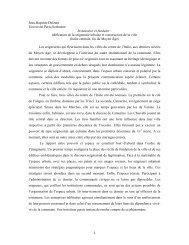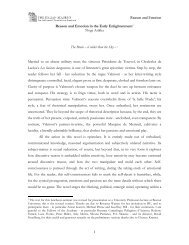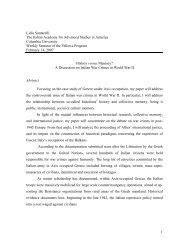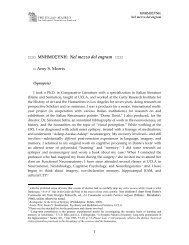Why are fertility and participation rates so low in Italy - The Italian ...
Why are fertility and participation rates so low in Italy - The Italian ...
Why are fertility and participation rates so low in Italy - The Italian ...
Create successful ePaper yourself
Turn your PDF publications into a flip-book with our unique Google optimized e-Paper software.
<strong>Why</strong> <strong>are</strong> <strong>fertility</strong> <strong>and</strong> <strong>participation</strong> <strong>rates</strong><br />
<strong>so</strong> <strong>low</strong> <strong>in</strong> <strong>Italy</strong> (<strong>and</strong> Southern Europe)?<br />
Datta Gupta N. <strong>and</strong> Smith N. (2000), “Children <strong>and</strong> C<strong>are</strong>er Interruptions: <strong>The</strong> Family Gap <strong>in</strong> Denmark, WP 00-<br />
03, Centre of Labour Market <strong>and</strong> Social Research, Aarhus<br />
De la Rica S. <strong>and</strong> Iza A. (2003), “<strong>The</strong> Role of Temporary Contracts <strong>in</strong> the Postponement of Maternity <strong>in</strong> Spa<strong>in</strong>:<br />
A Life-Cycle Stochastic Mode, Paper presented at the ESPE2003 Conference<br />
Del Boca D. (2002), “<strong>The</strong> Effect of Childc<strong>are</strong> <strong>and</strong> Part-Time on Participation <strong>and</strong> Fertility of <strong>Italian</strong> Women”,<br />
Journal of Population Economics, vol. 15(3), p. 549-73<br />
Del Boca D. (2003), “Do Childc<strong>are</strong> Costs affect Labor Supply?”, WP ChilD 2003<br />
Del Boca D. Lusardi A.(2003) “Credit market constra<strong>in</strong>ts <strong>and</strong> labor market decision of <strong>Italian</strong> Women” Labour<br />
Economics 3.<br />
Del Boca, D., (1997) “Intrahousehold Distribution of Re<strong>so</strong>urces <strong>and</strong> Labour Market Participation Decisions”,<br />
<strong>in</strong> Economics of the Family <strong>and</strong> Family Policies (Pers<strong>so</strong>n, I., Jonung C. eds ) Routledge Press.<br />
Del Boca D, (2001) “L’offerta di lavoro “ <strong>in</strong> Economia del lavoro Il Mul<strong>in</strong>o Bologna<br />
Del Boca D., Locatelli M. <strong>and</strong> Pasqua S., (2000), “Employment Decisions of Married Women: Evidence <strong>and</strong><br />
Explanation”, Labour, vol. 14, pp. 35-52<br />
Del Boca D. Locatelli M. Vuri D. (2003), “What Child C<strong>are</strong> Works Best? Evidence from <strong>Italy</strong>”, WP ChilD 2003<br />
Del Boca D., Pasqua S. <strong>and</strong> Pronzato C. (2003), “Analyz<strong>in</strong>g <strong>participation</strong> <strong>and</strong> <strong>fertility</strong> <strong>in</strong> Europe”, Paper<br />
presented at the European Conferences on ECHP <strong>and</strong> Report for the European Union of the Project<br />
MOCHO (<strong>The</strong> Rationale of Motherhood Choices: Influence of Employment Conditions <strong>and</strong> of Public<br />
Policies)<br />
Del Bono E. (2001), “Estimat<strong>in</strong>g Fertility”, Work<strong>in</strong>g Paper 2001 University of Oxford, Pembroke College<br />
Engelhardt H., Kogel T. <strong>and</strong> Prskawetz A. (2001), “Fertility <strong>and</strong> Female Employment reconsidered”, MPIDR<br />
Work<strong>in</strong>g Paper WP 2001-021 Max Planck Institute for Demographic Research<br />
Engelhardt H. <strong>and</strong> Prskawetz A. (2002), “On the Chang<strong>in</strong>g Correlation Between Fertility <strong>and</strong> Female<br />
Unemployment Over Space <strong>and</strong> Time”, MPIDR Work<strong>in</strong>g Paper WP 2002-052 Max Planck Institute<br />
for Demographic Research<br />
Ermisch J. (1989), “Purchased Childc<strong>are</strong>, Optimal Family Size <strong>and</strong> Mother’s Employment: theory <strong>and</strong><br />
Econometric Analysis”, Journal of Population Economics, vol. 2(2), p. 79-102<br />
Ermisch J. <strong>and</strong> Wright R. (1993), “Wage Offers <strong>and</strong> Full-Time <strong>and</strong> Part-Time Employment by British Women”,<br />
Journal of Human Re<strong>so</strong>urces, vol. 28(1), p. 111-33<br />
Esp<strong>in</strong>g A. G. (1999), Social Foundations of Post Industrial Economies, Oxford University Press, Oxford<br />
Gauthier A.H. <strong>and</strong> Hatzius J. (1997), “Family Benefits <strong>and</strong> Fertility: An Econometric Analysis”, Population<br />
Studies, vol. 51(3), p. 295-306<br />
Gornick J., Meyers M., <strong>and</strong> Ross K., (1997), “Support<strong>in</strong>g the Employment of Mothers : Policy Variation across<br />
Fourteen Welf<strong>are</strong> States”, Journal of European Social Policy, vol. 7, p.45-70<br />
Gornick J. C., Meyers M. K. <strong>and</strong> Ross K. E. (1998), “Public Policies <strong>and</strong> Employment of Mothers: A Cross-<br />
National Study”, Social Science Quarterly, vol. 79, p. 35-54<br />
Gustafs<strong>so</strong>n S. <strong>and</strong> Wetzels C. (2000), “Optimal age at first birth: Germany Grate Brita<strong>in</strong>, the Neherl<strong>and</strong>s <strong>and</strong><br />
Sweden” <strong>in</strong> Gustafs<strong>so</strong>n S. <strong>and</strong> Meulders D. (eds.), Gender <strong>and</strong> the Labour Market, Mac Millan<br />
London<br />
Gutièrrez-Domènech M. (2002), “Job Penalty after Motherhood: A Spanish Case <strong>in</strong> a European Context”,<br />
Family Friendly Policies Conference IZA Conference, May, Bonn<br />
Kelly E. <strong>and</strong> Dobb<strong>in</strong> F. (1999), “Civil Rights Law at Work: Sex Discrim<strong>in</strong>ation <strong>and</strong> the Rise of Maternity Leave<br />
Policies”, American Journal of Sociology, vol. 105(2), p. 455-492<br />
22
















